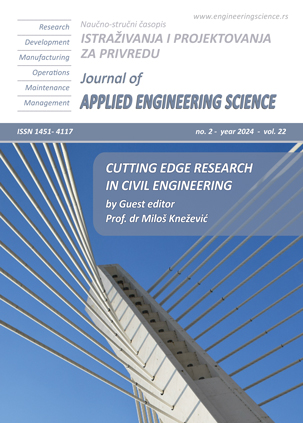3D DOCUMENTATION OF CULTURAL HERITAGE USING TERRESTRIAL LASER SCANNING
Abstract
This study presents a comprehensive exploration of the application of terrestrial laser scanning (TLS) technology for the 3D documentation of cultural heritage, focusing on the iconic Clock Tower of Tirana as a case study. Terrestrial laser scanning has emerged as a powerful tool in the field of cultural heritage preservation, offering a non-intrusive and highly accurate method for capturing the intricate details of historical structures. The research employs state-of-the-art TLS equipment to create a detailed 3D model of the Clock Tower, a prominent cultural landmark in Tirana, Albania. The methodology involves scanning the exterior of the tower, capturing its architectural features, ornate decorations, and historical elements. The high precision of TLS facilitates the generation of a point cloud, enabling the creation of an accurate digital replica that serves as a valuable resource for conservation, research, and education. The study also explores the challenges and benefits associated with TLS technology in the context of cultural heritage documentation. Issues such as data processing, registration, and integration of multiple scans are addressed, emphasizing the importance of a meticulous approach to ensure the reliability of the 3D model. Additionally, the research highlights the potential of the digital model in supporting conservation efforts, risk assessment, and virtual tourism, promoting accessibility and understanding of cultural heritage for a wider audience. The findings of this study contribute to the growing body of knowledge on 3D documentation techniques for cultural heritage preservation and provide insights into the specific application of terrestrial laser scanning in the context of the Clock Tower of Tirana. The results underscore the significance of leveraging advanced technologies to safeguard and promote the rich cultural heritage embedded in historical structures, fostering a deeper appreciation for the past while ensuring its preservation for future generations
References
Akgul M., Yurtseven M., Gulci S., Akay A.E. (2018). Evaluation of UAV and GNSS-Based DEMs for Earthwork Volume. Arabian Journal for Science and Engineering, vol. 43, no. 4, pp. 1893-1909, DOI: 10.1007/S13369-017-2811-9
Balázsik V., Tóth Z., Abdurahmanov I. (2021). Analysis of Data Acquisition Accuracy with UAV. International Journal of Geoinformatics, vol. 17, no. 1, pp. 1-10, DOI: 10.52939/ijg.v17i1.1697
Erdelyi J., Kopacik A., Kyrinovic P. (2018). Construction control and documentation of facade elements using terrestrial laser scanning. Applied Geomatics, vol. 10, no. 2, pp. 113-121, DOI: 10.1007/s12518-018-0208-4
Hassan A.T., Fritsch D. (2019). Integration of Laser Scanning and Photogrammetry in 3D/4D Cultural Heritage Preservation—A Review. International Journal of Applied Science and Technology, vol.9, no.4, pp. 9-16, DOI: 10.30845/ijast.v9n4p9
Jaafar H.A., Meng X., Sowter A., Bryan P. (2017). New approach for monitoring historic and heritage buildings: Using terrestrial laser scanning and generalized Procrustes analysis. Structural Control and Health Monitoring, Vol. 24, no. 11, DOI: 10.1002/stc.1987
Kwoczynska B., Piech I., Polewany P., Gora K. (2018). Modeling of sacral objects made based on aerial and terrestrial laser scanning. Baltic Geodetic Congress, pp. 275-282. DOI: 10.1109/BGC-Geomatics.2018.00059
Logothetis S., Delinasiou A., Stylianidis E. (2015). Building information modelling for cultural heritage: a review. ISPRS Annals of Photogrammetry, Remote Sensing and Spatial Information Sciences, Vol. II-5/W3, pp. 177-183, DOI: 10.5194/ISPRSANNALS-II-5-W3-177-2015
Mohammadi M., Rashidi M., Mousavi V., Karami A., Yu Y., Samali B. (2021). Quality evaluation of digital twins generated based on UAV photogrammetry and TLS: bridge case study. Remote Sensing, vol.13, no. 17, pp.3499, DOI: 10.3390/rs13173499
Moon D., Chung S., Kwon S., Seo J., Shin J. (2019). Comparison and utilization of point cloud generated from photogrammetry and laser scanning: 3D world model for smart heavy equipment planning. Automation in Construction, vol. 98, pp. 322-331, DOI: 10.1016/j.autcon.2018.07.020
Mulakala J. (2015). Measurement Accuracy of the DJI Phantom 4 RTK & Photogrammetry. https://www.gim-international.com/files/23b0ad77f81a0aa56e8c83f8c4300270.pdf (Accessed: 28 October 2023).
Pritchard, D., Sperner, J., Hoepner, S., and Tenschert, R. (2017). Terrestrial laser scanning for heritage conservation: the Cologne Cathedral documentation project. ISPRS Ann. Photogramm. Remote Sensing. Spatial Inf. Sci., IV-2/W2, pp. 213–220, DOI: 10.5194/isprs-annals-IV-2-W2-213-2017
Pompejano F. (2020). From national to cultural monuments: an overview of architectural heritage protection in Albania (1912-1992). Journal of Architectural Conservation, vol.26, no. 1, pp. 55-70, DOI:10.1080/13556207.2019. 1684021
Remondino F. (2011). Heritage recording and 3D modeling with photogrammetry and 3D scanning. Remote Sensing, vol. 3, no. 6, pp. 1104-1138, DOI: 10.3390/rs3061104
Rodríguez-Gonzálvez P., Jiménez Fernández-Palacios B., Muñoz-Nieto Á.L., Arias-Sanchez P., Gonzalez-Aguilera D. (2017). Mobile LiDAR System: New Possibilities for the Documentation and Dissemination of Large Cultural Heritage Sites. Remote Sensing, vol. 9, no. 2, pp.189, https://doi.org/10.1016/j.culher.2019.12.013
Wang Y., Chen Q., Zhu L., Liu L., Zheng, L. (2019). Survey of Mobile Laser Scanning Applications and Key Techniques over Urban Areas. Remote Sensing, vol. 11, no. 13, pp. 1540, DOI: 10.3390/rs11131540
https://www.g2metric.co.il/product/faro-laser-scanner-focus-m70/, (Accessed: 30 May 2024).

